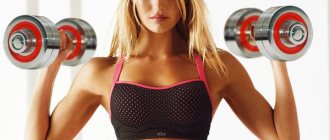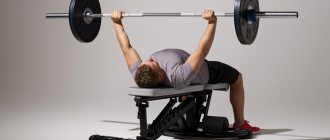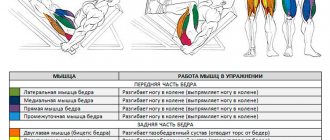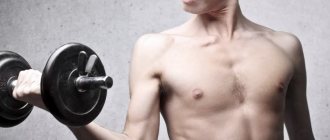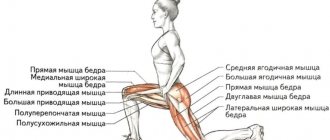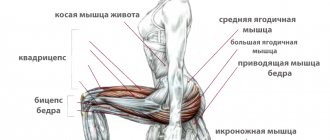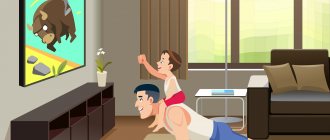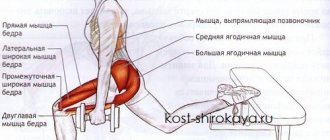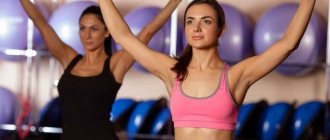| How can you replace lunges with bad knees? | Description |
| Swing your legs to the sides, forward, back | You can perform this exercise while lying on your side, standing, or on all fours. The technique is as simple as possible and should not cause difficulties even for beginners. If lunges with dumbbells cause discomfort, then leg swings will be a good alternative to such an exercise. You can perform them not only in the gym, but also at home. |
| Deadlift | You can perform this exercise with a barbell or dumbbells. The grip option may also differ; it can be:
The latter option requires one hand to perform a forward grip and the other a reverse grip. Which one is more relevant depends on individual preferences. Deadlifts can also be performed with your toes placed on plates. This allows you to increase the load on the gluteal muscles and hamstrings. |
| Gluteal bridge | The main advantages of the exercise:
|
Lunges with dumbbells are several variations of an exercise that is considered basic. They are aimed at developing quadriceps and gluteal muscles. They are usually performed after heavy basic exercises. Lunges can be done not only with dumbbells, but also with a barbell.
Despite their high effectiveness, sometimes you have to look for something to replace lunges, for example, with sore knees.
It should be noted that in this case, only a specialist should choose exercise options. In addition, there is no specific exercise that can fully replace lunges. You can find a replacement that will be aimed at working the muscles that are used during lunges.
With what weights can you do Bulgarian lunges?
If you can do 15-20 Bulgarian lunges per set, maintain good form and not lose your balance, try doing the exercise with weights.
With two dumbbells or kettlebells
Place the shells on the floor one step away from the support. Take a starting position with your leg elevated, perform a squat and hold a dumbbell or kettlebell in each hand. Straighten up, holding the weight in your lowered arms, and repeat again.
With one dumbbell or kettlebell
Take a dumbbell or kettlebell and hold it with bent arms in front of your chest. Perform Bulgarian lunges, trying to keep your back straight and not lean forward.
In the Smith machine
Place a bench or stand one step away from the machine, take the bar on your shoulders and remove the apparatus from the racks. Place your toes on an elevated platform and perform lunges using the usual technique, holding the bar with your hands on your shoulders.
The benefits and harms of exercise
The benefits of Bulgarian lunges are obvious: this is an excellent exercise for comprehensively working the leg muscles. It is suitable for both men who want to achieve developed muscular legs, and young girls who simply want to keep themselves in good shape and not gain excess weight.
Bulgarian lunges do not carry any particular potential harm. Isolated cases where athletes were injured while performing them are associated with their own carelessness and excessive self-confidence.
The cause of injury can be: excessively heavy working weight, incorrect technique of performing the exercise, lack of stretching for comfortable performance.
However, do not forget that the exercise still contains a certain element of axial load on the spine. Therefore, you should not get carried away with heavy working weights here - this way you will overload the joint-ligamentous apparatus, already tired from basic exercises. People who have suffered an umbilical hernia are advised to use an athletic belt when performing Bulgarian lunges, as with other leg exercises.
Scissor lunges are a variation of squats for strong quads and glutes.
One of the most popular lunge variations is the standing or scissor lunge. They are used in training programs for both men and women, regardless of their goals. Using scissors, you can form voluminous quadriceps, or tighten your hips and create a beautiful shape for the gluteal muscles.
Read also: Cardio training in the gym
What muscles work in scissor squats?
Two main muscle groups are heavily affected:
- quadriceps femoris (rectus, vastus lateralis, vastus medialis, vastus intermedius);
- as well as the gluteus maximus and gluteus medius muscles.
During the execution, the tensor fascia lata is activated.
Features of the exercise
The great advantage of the exercise is its versatility; scissor lunges are recommended for everyone, during the period of muscle gain or cutting, when working on endurance. The exercise is a basic one; it can be performed either with free weights or in a Smith machine.
pros
- A universal exercise - suitable for men and women at any time of training.
- A multi-joint exercise that simultaneously trains several muscle groups - quadriceps and buttocks.
- Accelerates metabolism, improves both the anabolic effect on the body as a whole, and promotes the burning of subcutaneous fat under certain loads.
- Stretches muscles, allowing muscles to recover faster after strength exercises.
Minuses
- If the technique is incorrect, the knee joint may shift forward, which can cause meniscus loss.
- Balance skills are required as poor balance can lead to falls and injury.
Technique for performing lunges in place
Important! Before performing lunges, you need to warm up and stretch your muscles well!
- Stand straight, place your palms on your waist.
- Take a long step forward, placing your front foot completely on the floor and your back foot on your toes.
- As you inhale, slowly lower yourself into a squat, keeping your back knee off the floor and your front knee off your toe. The thigh is lowered until it is parallel to the floor, the knee and heel remain in the same plane.
- Do not lower your body forward, do not rotate your pelvis.
- As you exhale, lift your pelvis more quickly, keeping the entire body support on the heel of your front foot. Concentrate on strengthening your glutes.
- Perform the exercise first on the right leg, then on the left leg. Keep your balance.
- Having received a load on both legs, rest for 1 minute and proceed to the second approach.
You can make the exercise more difficult using a platform. The supporting (front) leg stands on the platform, the second - the toe on the floor. The technique of movement remains the same, do not rush to return the foot from the hill, keep your balance.
Scissor lunges with dumbbells
- Take dumbbells, lower and relax your arms, holding the dumbbells on the sides of your hips.
- Place your right foot forward, lunge to one side, then switch.
- Follow the same technique for performing the exercise as with the version without weight ↑.
Scissor lunges with pancakes
- Take one plate (depending on the required load weight) in both hands, keep your palms on the sides of the projectile. Bend your elbows and hold the plate at chest level, maintaining this position for the entire approach.
- As in the previous version, perform it on one leg, then on the other leg.
- After performing, straighten your elbows and lower the plate to the floor or bench.
Lunges with a barbell
- Place the barbell on your shoulders, take it from the floor or from the racks, observing safety precautions, tighten the weights with special locks. Hold the barbell with a wide grip.
- Take a careful step forward with your right foot, maintain balance, start with light weights.
- Perform an approach on the right, then on the left leg.
- Once completed, place your feet together and remove the barbell from your shoulders.
Smith Scissor Lunge
As with the barbell option, perform lunges in the machine, placing the bar on your shoulders - remove it from the racks, turning it with your palms, and remove the locks. Place one foot forward and the other back on your toes. Keep your knee at a right angle. With the help of a simulator, maintaining balance is much easier. Do the same amount on both legs. Scissor lunges in Smith photo
Conclusion
The scissor technique is not so simple, sometimes it requires mastering without any equipment. Beginners can perform lunges with their own weight, or using an elevated platform. Girls should master the technique with light weight; the wider the distance between the feet, the more the gluteal muscle works and stretches. Men can work with a narrower foot stance to increase stress on the quadriceps.
Lunge technique
The exercise itself - lunges - is basic for working on the muscles of the legs (especially the quadriceps) and buttocks.
Here is the technique for performing lunges:
- choose 2 dumbbells of a feasible weight, take the starting position, standing straight, lower your arms with dumbbells to your sides, and look straight in front of you;
- step forward with one leg, bend it at the knee and squat, the other leg should remain straight and the shin should be parallel to the floor;
- keep your body straight, your working leg bent at the knee 90 degrees and not protruding beyond the toe of this leg;
- crouching as much as possible, stay in this position for a few seconds, then, tensing the quadriceps muscle as much as possible, slowly rise up, helping with your supporting leg;
- now straighten up and put your leg in the starting position, while tightening the muscles of the buttocks and abdominals, and, returning to the starting position, repeat the same with the other leg;
- perform 8-10 repetitions on each leg - 4 sets in total.
Emphasis on quadriceps and glutes
If we analyze which muscles work during lunges with dumbbells, we get the following picture:
- The quadriceps (quadriceps muscle of the thigh, occupies its anterior surface) is one of the two main working groups. This muscle extends the leg at the knee joint when we rise from the lowest point.
- The gluteus maximus muscle (makes up the bulk of the buttocks) - along with the quadriceps, experiences significant stress when extending the hip when lifting up.
In addition to the quadriceps and gluteus maximus, the following muscles take part in the work: the abdominal muscles, gluteus medius, hamstrings, back muscles, calf muscles, etc. The main function of the listed muscles in this exercise is to stabilize the position of the body and legs. It’s not for nothing that the movement is called coordination complex - it’s really not always possible to maintain balance the first time. You can also mention the arm muscles with which you hold dumbbells - they work statically.
By varying the width of your step when performing lunges with dumbbells in your hands, you can shift the load towards the buttocks or towards the quadriceps:
- The step is wider, the supporting leg has an angle at the knee of more than 90 degrees - the gluteal muscle stretches better and works more. This is the best option for most girls. However, the wider your feet are, the less comfortable it is to step and walk back.
- The step is narrower, the supporting leg is bent at a right angle - the front surface of the thigh is more involved.
The technique of lunges with dumbbells in hands allows for different step widths, with the only caveat that the legs should not be too close to each other or, conversely, too wide. Too close is when the working leg begins to extend the knee beyond the line of the toe. Too wide is when the supporting leg is almost straight. In a wide position, with good stretching, you can do lunges in place, but not dynamically.
Practical tips and advice
- When performing reverse lunges, dumbbells should be held using the entire hand, not just the fingers; The barbell should be supported by your hands and not slung over your shoulders.
- The position of the back at all stages of movement remains invariably straight and is in no way rounded.
- The body, like the back, is held straight. Tilts in any direction are not allowed.
- If you are a beginner, you should not avoid the support at first. Over time, when the muscles get stronger, the support can be removed and you can begin to perform the exercise yourself.
- During the exercise, the gaze should be directed forward, the neck should serve as a continuation of the ridge, otherwise you can stretch the muscles or injure the vertebrae of this section.
- If you are poorly stretched, the exercise may be difficult at first, so you need to warm up and do some stretching. The main thing is not to overdo it. At first it will be possible not to lower yourself completely until the muscles become sufficiently elastic.
https://youtube.com/watch?v=yRAENv5up68
What muscles work
Lunges with dumbbells work the following muscle groups:
- quadriceps femoris;
- hamstring biceps;
- gluteal muscle.
Essentially, lunges are alternating steps with full range of squats on the leg. Moreover, the wider the step, the greater the load on the buttocks and hamstrings. With a narrow stride, the quadriceps will work more. You can independently vary the load between these muscle groups. Also during the training, the abs, calf muscles, back, and arms work.
Three gluteus maximus muscles
Gluteus maximus muscle
Did you know that the gluteus maximus muscle is the largest muscle in the entire human body? Its job is to support the torso in an upright position, which is the reason for its size and power.
As the name suggests, it is the largest and closest to the surface muscle of the entire gluteal muscle group.
The function of the gluteus maximus muscle is mainly to extend the upper legs (hips) - for example, when rising from a squat position. Another example of including this muscle in work is lifting the torso tilted forward. Picture yourself swinging a kettlebell and you'll get a good idea of how this muscle works.
Hip extension also occurs during deadlifting, pushing off the legs during running and skating, and simply while swinging the leg.
This muscle is also involved in turning the leg - for clarity, imagine, for example, a duck walk.
Gluteus medius muscle
The gluteus medius is the smallest of the gluteal muscle group, located beneath the gluteus maximus and provides stability to the hip joint, especially when standing on one leg. Thus, when walking or running (where the legs are used in turns) or climbing stairs, the gluteus medius muscle is tensed to prevent the pelvis from sinking to one side.
Moreover, the gluteus medius (and minimus) are involved in hip abduction.
Gluteus minimus
It is the smallest of the gluteal muscle group, located directly below the gluteus medius. Its main function is to provide stability to the hip joint. It works together with the gluteus medius muscle.
I hope that this little anatomical excursion did not confuse you. Essentially, that's all you need to know to perform the exercises. Well, let's move on to...
What to replace lunges with at home?
As a rule, few people have a barbell at home. Meanwhile, lunges with it will be especially stressful. How to get the same effect?
“Lunges can be replaced by stepping onto a bed, stool or some kind of bench,” suggests Daniil Lobakine. — Place one foot on the stand, tilt your body forward and stand with the other leg. Then go the same way.”
Also, weights are an excellent substitute for squatting on one leg (with a pistol) or with one leg placed on a sofa stool. In the second case, the exercise is just as difficult. Like a squat on one leg, but the load on balance is less, because there is at least some support for the second leg.
Now you know how you can replace lunges with dumbbells or a barbell if you have no health restrictions. But what if they exist?
How to prepare for the exercise
Even before you begin the exercise, you should find a support of optimal height and provide sufficient distance to it to make lunges comfortable and safe.
How to find a suitable elevation
To check whether the height of the support is appropriate, stand a step away from it and turn your back, place the toe of your right foot on the edge and squat down until your right knee touches the floor.
If you feel a strong stretch in the front of your right thigh and cannot move your back foot, your support is too high - find something lower.
In the video, physical therapist and strength and conditioning specialist Aaron Horschig shows how the foot should move if the support for the Bulgarian lunges is chosen well.
How to get into the right position
Place your toes on the chosen elevation and lower yourself into a squat until your knee touches the floor.
Shift your body weight to your front leg as if preparing to stand up. In this position, the shin of the supporting limb and the body should be parallel to each other.
Frame: Squat University / YouTube
Make sure that the front leg is in line with the shoulder of the same name. For most people this position will be comfortable.
Frame: Squat University / YouTube
Leg press
For this exercise you need a special simulator. It is available in almost any gym, since the bench press is one of the favorite exercises of bodybuilders.
The leg press perfectly loads the buttocks, hamstrings and quadriceps, while removing the stress from the lower back.
To perform the exercise correctly, sit in the machine, press your lower back to the back (remember that you cannot lift it!), Place your feet on the platform.
Bend your knees and smoothly lower the platform towards you. As you exhale, push it up.
By varying the position of your feet, you can shift the load to different parts of your legs and buttocks.
How deep should you squat?
Stopping flexion is, as you remember, one of the controversial issues. Let's say goodbye to the myth about the dangers of full squats. A healthy person who has no contraindications in the hips, knees or spine is able to withstand this exercise without harming himself. You can squat a quarter, a half, or a full depth with ease, as Powers and Salem proved in 2002. The research results are published in J Orthop Sports Phys Ther (32nd issue) on pages 141-148.
Read also: Carbon monoxide detector for home
Training program
The training program is not designed to be performed daily.
It is recommended to perform the complex with a rest of 1 day for better effect and quick results. The program contains the best exercises for the buttocks, which will not take more than an hour to complete, but will quickly pump up your Brazilian butt. Exercise Number of repetitions in a set Number of approaches on one leg Number of repetitions in a set Number of approaches on one leg
In the third week, we increase the number of approaches by 1-2 in each exercise. The increase should depend on physical fitness. On the first day, it is better to add 1 set of each exercise, and then towards the end of the week add another set.
In the fourth week, the maximum number of approaches from last week remains, but each exercise in the complex increases by 5-10 repetitions.
Recommendations for implementation
- To make your stance more rigid, experiment with the width of your feet. You can also turn the foot of the front leg slightly inward.
- The wider you place your feet, the more the gluteal muscles are activated. Accordingly, with a narrower setting, the quadriceps is included.
- If you want to increase the load on the gluteal muscles, then tilt your body slightly forward towards the hip. This way you will stretch this area more at the bottom point.
- Without swaying from side to side. This way you will perform the exercise by inertia and will not be able to fully engage the target muscles.
- Do some stretching at the end of every leg workout. This will make your muscles and joints more elastic.
What to replace lunges with?
If there are contraindications to performing lunges - problems with the spine and knee joints, ankle injuries - you can replace the exercise with a number of equally effective techniques. The main thing is to understand which muscles are involved during lunges.
To work the gluteal muscles, the exercise can be replaced with hyperextension, gluteal bridge, or backward leg swings. Although these exercises isolate the load on the buttocks without involving the quadriceps in the work, they do not injure or overload the joints.
work your quadriceps in a seated calf extension machine, but it is very important not to straighten your knee completely and select the optimal load weight. You can also replace lunges with a leg press machine. In this exercise, both the gluteal and quadriceps muscles are simultaneously activated, however, the knees are also under load, but it can be performed for varicose veins, since the blood flows from top to bottom (in the direction of lymph flow).
Reasons for substituting alternative exercises
There are three main reasons why an alternative to squats is needed:
- Spinal and knee injuries
Diseases and injuries of the musculoskeletal system limit or completely eliminate the possibility of performing the classic version of the exercise.
- Adaptation of leg muscles to the same type of movement
Getting your muscles used to the same loads reduces or completely stops the growth of muscle mass and strength, and you have to look for other variations.
- Improved proportions
Due to the uneven load on the thigh muscles, there is a need to pump them at unusual angles. The goal is more proportional and harmonious development of the legs.
Back lunges (reverse lunges) and forward lunges
video lunges correct backward lunges (reverse lunges) and correct forward lunges
The classic version is forward lunges. You step forward with one leg, while the other remains behind. But you can also do backward lunges (reverse lunges). The difference is that instead of taking a step forward, you take a step back.
Back lunges are less damaging to your knees. Therefore, if you feel pain in your knee during forward lunges, then try backward lunges.
You can combine backward lunges (reverse lunges) and forward lunges - first step forward with one leg, then back with the same leg. This is 2 reps. A total of 10 such repetitions. Then change your working leg and do another 10 repetitions. This is 1 approach, you need 3 in total.
Benefits of Exercise
The effect of Bulgarian lunges is close to the effect of classic lunges and squats, but has its own characteristics.
- Compared to lunges, and even more so with squats, this option allows you to isolate the thigh muscles of one leg more and specifically work them.
- Balance and focus are greatly developed, which helps with other complex compound exercises, especially with additional weight.
- There is an opportunity to work more and strengthen the muscles of the lagging leg (often one leg is weaker than the other).
- This exercise works well on the gluteal muscles, allowing you to tighten them and increase their volume.
- The knee joint can be strengthened and stabilized.
- For some sports, it is important to increase the propulsion power of the leg, which can also be done with this exercise.
- Bulgarian lunges have great variability in execution.
- An important factor is accessibility and simplicity. The exercise can be done anywhere.
How to do lunges to avoid knee pain?
Although classic lunges are performed with dumbbells or a barbell, you should start without them. The main thing is to master the correct technique, which will protect the joints from injury and maintain the health of the lower back.
“You can take a small weight and do shallow lunges with a small amplitude, gradually increasing the weight and pace,” advises Daniil Lobakin. “Even weightlifters do their first approach with an empty bar so that the body remembers how to do the exercises correctly.”
To protect your knee joints, it is important to consider the load on them not only in this specific exercise, but in your overall training program. After all, the leg joints are involved not only in lunges. Therefore, when planning exercises, you need to dose the load on the thigh and buttocks, because it is exercises for them that usually load the knee.
Can squats give you abs?
They can. The abdominal planks develop in parallel with the back extensors. Your body works in harmony, which leads to improved coordination and an overall beautiful figure. So do squats and get your belly toned.
Summarize . No matter what type of squats you do, your butt, abs, and thighs will be greatly strengthened. Are you involved in athletics or team sports? And here you can’t do without squats as an auxiliary workout. The main thing is to select the depth with the help of an experienced coach.
How to replace lunges with dumbbells?
The choice of replacement also depends on your health and physical fitness.
“For sore knees, you can replace lunges with simpler exercises on machines or exercises for the leg muscles in a lying position,” says Sergey Kiselev, an expert in X-Fit gyms in Russia. “ Exercises using additional equipment will give a suitable effect: fitness band, fitball, TRX loops, etc.”
If the inability to do lunges results from poor physical shape, then they should be done without dumbbells and with your hand resting on a wall or chair. Or replace it with a squat: it places less demands on balance, since the legs are in an anatomically more comfortable position. Having strengthened the muscles with squats, you can do the lunges themselves. But if the problem is in the joints, then squats will overload them just like lunges.
“The lunges themselves can be made safer,” explains Sergey Kiselev. — First, remove the dumbbells (or barbell). Secondly, change the direction of movement when lunging and see how changing this parameter will affect the feeling in your knees. Try lunges not only forward, but also backward, to the side, and diagonally. The main thing is to maintain control of the technique while moving. The back lunge may be the best choice for you. The more complex the exercise is in coordination, the more difficult it is to maintain control in the joint. Therefore, choose the simpler option for yourself first.”
Thirdly, during lunges you can focus on different movements: in the knee joint, or the hip joint, or stick to an average option between these two. For problems in the knees, an option with an emphasis on the pelvis or an average one may be suitable.
Lunges for scoliosis
Recommendations for training for scoliosis are purely individual and can only be given after a medical diagnosis. “The coach needs to understand what he is dealing with,” explains Sergei Kiselev. — Is it functional scoliosis associated with muscle imbalance, or an idiopathic disease where bone structures are involved? What is the degree of scoliosis? Is this a teenager who is still growing, or is this an adult? Lunges may be one of many exercises for a given person, but they are far from the main one if the goal is to correct scoliosis.”
Leg bending and extension in the simulator
Leg curls and extensions are 2 exercises that every bodybuilder performs, regardless of training level.
We have combined them into one item because they almost always go together.
The first one works the hamstrings:
And the second is the quadriceps:
They are attractive due to their simplicity of execution, but at the same time seriously stimulate the leg muscles.
The exercises are performed in special simulators.
The movement in both cases occurs in one joint - the knee. Only the effort in each exercise is directed towards the opposite movement.
In Flexion, the goal is to bend the leg, and in Extension, on the contrary, to straighten it (which is quite logical and is clear from the name).
Variations
- Dynamic lunges. They are also “stepping lunges,” but this name is less common. They are regular lunges, but with a step back. It is necessary to take the starting position each time. The working leg does not move, only the supporting leg walks;
- Lunges along the width of the step - with a medium width, with a large one and split squats. Accordingly, foot placement affects muscle accents. The split squat works more on the hamstrings, the wide step on the buttocks, and the classic squat on the quadriceps;
- Walking lunges are “walking” across the gym with lunges, that is, stepping, bending your knees and hips, and stepping forward with your supporting leg. For some strange reason, it is believed that this is the best lunge for buttocks, girls, weight loss and advertising fitness training. In fact, it is an exercise for the quadriceps, in most variations.
httpv://www.youtube.com/watch?v=embed/wyeBwTMtagA
